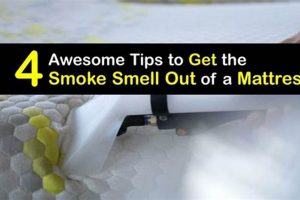The remediation of urine stains and odors from mattresses is a necessary process to maintain hygiene and prolong the lifespan of bedding. Failure to adequately address urine contamination can lead to unpleasant smells, discoloration, and potential bacterial growth within the mattress fibers. For example, a mattress that has been soiled with urine may develop a lingering ammonia scent, which can be particularly noticeable in humid conditions.
Proper mattress cleaning is crucial for creating a healthy sleep environment. Effectively removing urine not only eliminates unsightly stains but also prevents the buildup of harmful bacteria and allergens. Historically, various methods have been employed, ranging from simple sun-drying to the application of harsh chemicals. Modern techniques offer a more effective and less damaging approach to restoration, prioritizing both cleanliness and material preservation.
The following sections will detail specific procedures and recommended products for the effective treatment of urine contamination in mattresses, encompassing stain removal, odor neutralization, and preventative measures to ensure long-term mattress hygiene.
Effective Strategies for Mattress Urine Removal
The following outlines effective strategies for addressing urine contamination in mattresses, emphasizing thorough cleaning and odor elimination.
Tip 1: Immediate Action: Promptly address the urine stain. The longer urine remains on the mattress, the deeper it penetrates, making removal more challenging. Absorb excess liquid with clean towels.
Tip 2: Blot, Do Not Rub: When absorbing urine, use a blotting motion. Rubbing can spread the stain and drive it further into the mattress fibers. Apply consistent pressure with clean, absorbent cloths.
Tip 3: Baking Soda Application: Cover the affected area generously with baking soda. Baking soda absorbs odors and helps draw moisture out of the mattress. Allow it to sit for several hours, preferably overnight.
Tip 4: Vacuum Thoroughly: After the baking soda has sat, vacuum the area thoroughly using an upholstery attachment. Ensure all baking soda residue is removed from the mattress surface.
Tip 5: Enzyme Cleaner Usage: Apply an enzyme-based cleaner specifically designed for urine removal. These cleaners break down the uric acid crystals that cause persistent odors. Follow the manufacturer’s instructions carefully.
Tip 6: Hydrogen Peroxide Solution (Caution Advised): For stubborn stains, a solution of 3% hydrogen peroxide mixed with a small amount of dish soap can be used. Test the solution on an inconspicuous area of the mattress first to check for colorfastness. Apply sparingly and blot dry.
Tip 7: Air Drying: Allow the mattress to air dry completely after cleaning. Using a fan can expedite the drying process. Avoid placing bedding on the mattress until it is fully dry to prevent mildew growth.
Effective stain and odor removal hinges on swift action and the correct application of appropriate cleaning agents. Allowing the mattress to dry completely is crucial to prevent further complications.
The concluding section will provide insights into preventing future occurrences and maintaining optimal mattress hygiene.
1. Immediate Absorption
The effectiveness of urine removal from a mattress is significantly determined by the speed and thoroughness of immediate absorption efforts. Delay in addressing the spill permits urine to permeate deeper into the mattress fibers and internal structure, exacerbating the staining and odor issues. This deeper penetration necessitates more intensive and potentially damaging cleaning procedures to attempt full remediation. As a cause, delayed action contributes directly to the severity of the problem. As an effect, the problem can result in a stain and the lingering odor. For instance, a small spill addressed immediately may require only surface treatment, while a similar spill left unattended for several hours might necessitate deep cleaning or even mattress replacement. A practical example of this is parents cleaning up an accident promptly, versus one left overnight. The prompt one will prevent permanent damage, while the second will create permanent damage.
The principle of immediate absorption aligns with the physics of fluid dynamics and material science. Mattress materials, often porous and absorbent, act as capillaries, drawing liquids inward. Immediate action disrupts this capillary action, limiting the amount of urine that can be drawn into the deeper layers. Proper absorption involves the use of highly absorbent materials like paper towels or microfiber cloths, applied with consistent pressure. It is critical to blot rather than rub, as rubbing further drives the urine into the mattress. The chosen absorbent material must be able to draw the liquid out, without simply smearing it around. The practical application is, ensuring to have cleaning material available for such accidents.
In conclusion, the practice of immediate absorption serves as a cornerstone for successful urine removal from mattresses. The reduced stain, diminished odor, and less invasive cleaning procedures directly result from swift and effective absorption. Understanding this principle is crucial for anyone seeking to maintain a hygienic and long-lasting mattress. While complete elimination of all traces is not always guaranteed, the probability of successful restoration is dramatically increased with prompt action. Further, this step reduces the reliance on harsh chemical cleaners, contributing to a safer and healthier home environment.
2. Enzymatic Cleaners
Enzymatic cleaners play a critical role in urine removal from mattresses, providing a mechanism to break down the complex organic compounds responsible for stains and odors. Their specialized formulation targets the source of the problem, rather than simply masking the symptoms, making them indispensable for effective mattress restoration.
- Enzyme Action on Uric Acid
Uric acid crystals, a primary component of urine, are the main contributors to persistent odors. Traditional cleaners often fail to completely eliminate these crystals. Enzymatic cleaners, however, contain enzymes specifically designed to break down uric acid into smaller, odorless compounds. This process effectively neutralizes the source of the odor, rather than just covering it up with fragrances. For instance, a mattress that has been treated with a standard cleaning solution may still emit a faint urine smell, whereas one treated with an enzymatic cleaner will exhibit a significant reduction or complete elimination of the odor.
- Specific Enzyme Types and Their Functions
Different types of enzymes are used in enzymatic cleaners, each with a specific function. Proteases break down proteins, amylases target starches, lipases digest fats, and ureases specifically target urea. A comprehensive enzymatic cleaner will often contain a blend of these enzymes to address the various components of urine. The effectiveness of a cleaner depends on the specific enzymes included and their concentration. For example, a cleaner formulated primarily with proteases may be less effective at removing urine stains from pets that have high fat content in their urine.
- Application and Penetration
The application method is crucial for enzymatic cleaners to work effectively. They must penetrate the mattress fibers to reach the urine deposits. Saturating the affected area and allowing the cleaner sufficient dwell time is necessary for the enzymes to break down the uric acid crystals. Unlike surface cleaners that can evaporate quickly, enzymatic cleaners need time to react with the urine components. For instance, simply spraying the surface of a mattress with an enzymatic cleaner and wiping it immediately may not yield optimal results, compared to saturating the area and allowing it to sit for several hours.
- Material Compatibility and Safety
While enzymatic cleaners are generally safe for most mattress materials, it is essential to test the cleaner on an inconspicuous area first. Certain dyes or delicate fabrics may be affected by the enzymatic action. Furthermore, it is essential to choose cleaners that are non-toxic and safe for use around children and pets, especially in a sleeping environment. For example, a cleaner containing harsh chemicals, even if effective at stain removal, may pose a health risk compared to a biodegradable enzymatic cleaner.
In summary, the application of enzymatic cleaners is not merely a cleaning step but a biochemical process that targets the root cause of urine stains and odors in mattresses. By understanding the enzyme action, application method, and material compatibility, one can effectively restore a mattress to a hygienic and odor-free state. Their effectiveness surpasses that of basic cleaners, making them essential for effective mattress sanitation.
3. Odor Neutralization
Odor neutralization is a critical component of effectively addressing urine contamination in mattresses. The presence of residual odor indicates incomplete removal of the urine’s components, suggesting ongoing bacterial activity and potential for health concerns. The relationship between urine removal and odor elimination is intrinsically linked; successful removal of the source material directly contributes to odor reduction. For example, a mattress cleaned with a method that only addresses the stain but neglects the underlying uric acid crystals will likely continue to emit an odor, signaling inadequate treatment. A prompt and efficient odor neutralization demonstrates the success of cleaning and protects health.
Techniques for odor neutralization extend beyond simple masking with fragrances. Methods such as the use of baking soda, which absorbs odor molecules, and the application of enzymatic cleaners, which break down odor-causing compounds, are more effective. The correct application of these methods is paramount; simply sprinkling baking soda on the surface may not penetrate deep enough to reach the source of the odor. Similarly, the selection of an appropriate enzymatic cleaner, one specifically formulated to address uric acid, is crucial for success. Consider the practical example of using activated charcoal filters in air purifiers, which physically trap odor molecules. This principle can be applied to mattress cleaning by ensuring that neutralizing agents come into direct and sustained contact with the contaminated areas. A complete removal will demonstrate the effectiveness of cleaning.
In conclusion, odor neutralization is an essential indicator of the thoroughness of urine removal from mattresses. Addressing odor requires a comprehensive approach, utilizing appropriate neutralizing agents and ensuring their proper application. The presence of lingering odor signifies incomplete cleaning and underscores the importance of employing effective and targeted methods. By focusing on odor elimination as a key metric, individuals can achieve a more hygienic and healthful sleep environment. Overlooking the cleaning process will demonstrate permanent damage to the mattress and an unhealthy sleeping environment.
4. Thorough Drying
Thorough drying is an indispensable component of mattress urine remediation. Its necessity stems from the inherent risk of moisture retention within the mattress core, which can foster microbial growth and perpetuate unpleasant odors, directly counteracting the efforts to get urine out of the mattress. The relationship between incomplete drying and unsuccessful urine removal is causative; residual moisture provides an environment conducive to bacterial proliferation, leading to persistent smells and potential structural damage to the mattress. For example, a mattress that appears surface-dry but retains moisture internally may develop mold, requiring professional cleaning or even replacement. The inverse is also true: a mattress cleaned and thoroughly dried will reduce the chances of these adverse effects.
The practical application of thorough drying involves several techniques. Air circulation is paramount; positioning the mattress in a well-ventilated area, ideally outdoors in direct sunlight (while being mindful of UV damage to certain materials), can facilitate the evaporation of moisture. The use of fans aimed at the mattress further accelerates the drying process. Dehumidifiers can be employed in enclosed spaces to reduce ambient humidity, thereby promoting moisture release from the mattress. Furthermore, the use of moisture meters can provide an objective assessment of the mattress’s dryness level, ensuring that it has reached an acceptable threshold before resuming normal use. For instance, after cleaning, a moisture meter reading above a certain percentage would indicate the need for continued drying efforts. It could also be possible that the mattress needs to be opened up to have the inside dry properly, with professional assistance.
In summary, thorough drying is not merely a concluding step in mattress urine removal but a critical safeguard against secondary issues arising from residual moisture. The direct correlation between effective drying and the prevention of microbial growth underscores its importance. Challenges in achieving complete dryness, particularly in thick mattresses, necessitate employing multiple drying techniques. The consequence of insufficient drying will negate the hard work done. Ultimately, the diligence and method involved in thorough drying ensures a hygienic and long-lasting result and a healthier sleep environment.
5. Preventative Measures
Preventative measures are intrinsically linked to the challenge of how to get urine out of mattress. Implementing proactive strategies significantly reduces the likelihood of urine contamination, minimizing the need for extensive cleaning and restoration efforts. The following outlines specific preventative measures and their impact on mattress hygiene.
- Waterproof Mattress Protectors
Waterproof mattress protectors constitute a physical barrier against liquid penetration. These protectors, typically made from materials like polyurethane or vinyl, shield the mattress from spills and accidents. For instance, in households with young children or pets, a high-quality waterproof protector can prevent urine from reaching the mattress fibers, simplifying cleanup and averting deep stains. This acts as the first line of defense and greatly reduces the need of finding out how to get urine out of mattress.
- Regular Mattress Maintenance
Routine maintenance practices, such as regular vacuuming and airing out the mattress, contribute to overall hygiene and early detection of potential problems. Vacuuming removes dust, allergens, and dried bodily fluids that can accumulate over time. Airing out the mattress allows for moisture evaporation, discouraging microbial growth. Early detection enables prompt action and prevents accidents from causing significant damage. If an accident is caught quickly it can be taken care of immediately without having to deep clean.
- Limiting Liquids Near the Bed
Restricting the consumption of liquids in the immediate vicinity of the bed reduces the chances of accidental spills. Implementing a “no drinks in bed” policy, particularly for children, can significantly minimize the risk of urine contamination or other liquid-related stains. This is one of the most simple ways to prevent stains and damage to your mattress.
- Proper Pet Care
For pet owners, ensuring pets have adequate access to designated relief areas and addressing any behavioral issues that may lead to indoor urination is essential. Regular walks, consistent training, and monitoring pet health can mitigate the risk of accidental urine marking on the mattress. Making sure the pet has places outside to do their business will prevent indoor accidents.
These preventative measures, when consistently implemented, significantly reduce the frequency and severity of urine-related mattress contamination. By prioritizing prevention, individuals can minimize the need for intensive cleaning procedures, prolong the lifespan of their mattresses, and maintain a healthier sleep environment. The focus shifts from reactive cleaning to proactive maintenance, resulting in reduced labor and time dedicated to stain removal..
Frequently Asked Questions
The following addresses common inquiries regarding the removal of urine from mattresses, providing clarification and guidance on effective techniques and best practices.
Question 1: Are standard household cleaners sufficient for removing urine from mattresses?
Standard household cleaners may mask odors temporarily but are generally ineffective at breaking down uric acid crystals, the primary cause of persistent urine smells. Enzymatic cleaners, specifically formulated for this purpose, are recommended.
Question 2: Can urine stains be completely removed from a mattress?
Complete stain removal depends on several factors, including the age of the stain, the type of mattress material, and the cleaning methods employed. Prompt action and the use of appropriate cleaning agents increase the likelihood of successful stain removal. Older stains will be harder to remove than new ones.
Question 3: Is professional mattress cleaning necessary for urine contamination?
Professional cleaning may be warranted for severe or deeply penetrated urine contamination. Professionals possess specialized equipment and cleaning solutions that can effectively address stubborn stains and odors. Hiring a professional is a viable option for extreme cases.
Question 4: Does baking soda truly eliminate urine odors from mattresses?
Baking soda acts as an odor absorbent, neutralizing some urine odors. However, it may not completely eliminate odors from deeply penetrated stains. Baking soda should be used in conjunction with other cleaning methods, such as enzymatic cleaners.
Question 5: How long does it take for a mattress to dry after urine removal?
Drying time varies depending on environmental conditions and the amount of liquid absorbed. Mattresses should be allowed to air dry completely, which may take several hours or even days. The use of fans or dehumidifiers can accelerate the drying process.
Question 6: Are there any health risks associated with urine-contaminated mattresses?
Urine-contaminated mattresses can harbor bacteria and mold, potentially leading to respiratory issues, allergic reactions, and skin irritations. Prompt and thorough cleaning is essential to mitigate these health risks. Make sure all cleaning is completed efficiently and effectively to avoid the risks.
Effective urine removal from mattresses requires a combination of appropriate cleaning agents, thorough drying techniques, and a proactive approach to prevent future contamination. Addressing the root causes of stains and odors is essential for maintaining a hygienic sleep environment.
The subsequent section will summarize the key steps for mattress urine removal, providing a concise guide for quick reference.
Conclusion
This article has explored various methods for effectively addressing urine contamination in mattresses. Key strategies include immediate absorption, enzymatic cleaning, odor neutralization, and thorough drying. Preventative measures, such as waterproof mattress protectors, are also critical for maintaining mattress hygiene. The consistent application of these principles will enhance the probability of successful remediation.
Effective mattress urine removal demands diligence and attention to detail. While complete restoration is not always guaranteed, the implementation of the outlined procedures minimizes health risks, prolongs mattress lifespan, and promotes a healthier sleep environment. Prioritizing proactive maintenance and swift action are essential to preserving the integrity of bedding investments.







